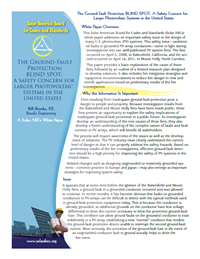
Ground-Fault Detection Blind Spot
Inverter Ground-Fault Detection "Blind Spot" and Mitigation Methods (June 2013)
Download the one-page summary (PDF, 314KB) or the full report (PDF, 3.5MB).
This report summarizes all research on this topic and includes a description of available mitigation methods.
Analysis of Fuses for "Blind Spot" Ground Fault Detection in Photovoltaic Power Systems (June 2013)
Download the one-page summary (PDF, 304KB) or the full report (PDF, 3.22MB).
This report presents results of modeling analysis done to examine the impact of fuse size on the blind spot detection issue.
The Ground-Fault Protection Blind Spot: Safety Concern for Larger PV Systems in the U.S. (January 2012)
Download the one-page summary (PDF, 360KB) or the full report (PDF, 432KB).
This white paper provides an explanation of the blind spot detection issue.
Overview

These Solar American Board for Codes and Standards (Solar ABCs) reports address an important safety issue in the design of many U.S. photovoltaic (PV) systems. This safety issue—undetected faults in grounded PV array conductors—came to light during investigations into two well-publicized PV system fires. The first occurred on April 5, 2008, in Bakersfield, California, and the second occurred on April 16, 2011, in Mount Holly, North Carolina.
The Solar ABCs has led a broad industry- and stakeholder-based working group to research this problem and develop effective mitigation strategies. This research first focused on developing a basic explanation of the cause of the detection blind spot. It includes results of field research conducted to characterize basic array wiring impedance properties and their effects on ground fault detection, circuit modeling, and analyses of high and low impedance faults that may occur throughout the array. It also includes a technical review of the effects of different array topologies (grounded, ungrounded, and grounded through the alternating current connection) on ground fault detection blind spots.
Why the Report is Important
Fires resulting from inadequate ground-fault protection pose a danger to people and property. Because investigation results from the Bakersfield and Mount Holly fires have been made public, these fires present an opportunity to explore the safety implications of inadequate ground-fault protection in a public forum. As investigators developed an understanding of the root causes of these fires, they also developed a better understanding of the complex nature of faults and fault currents in PV arrays.
The PV industry must clearly understand the current level of risk so that it can properly respond to safety hazards. Based on this research, improving ground-fault detection should be a high priority for ensuring the safety of PV systems in the United States.
Issue
It appears that at some time before the ignition of the Bakersfield and Mount Holly fires, a ground fault in a grounded conductor occurred and was allowed to continue. Faults on grounded conductors in PV arrays can be difficult to detect with the typical methods used in ground-fault protection equipment today. This is because the conductor is already grounded, so additional grounds on the conductor have less voltage differential to drive the current necessary to blow the protective ground-fault fuse. This condition can allow ground faults on the grounded conductor to exist indefinitely in a PV array, establishing a new "normal" condition that renders the ground-fault protection device unable to interrupt current from a second ground-fault (should one occur). More seriously, when two faults are present in this way, the activation of the ground-fault fuse in response to an ungrounded conductor fault to ground actually helps to drive the fire event.
Key Findings
Included in the first report are recommendations for operational strategies and equipment retrofits that can increase ground fault detection sensitivity and reduce the risk of fire in new and retrofit applications. Early results from large PV systems that have been retrofitted with the recommended protective devices indicate that these devices can substantially reduce the detection blind spot without requiring redesign of the system. The major mitigation strategies and equipment retrofit options include:
- following proper installation techniques with close attention to wire management,
- performing routine preventative maintenance to identify and resolve progressive system damage,
- introducing data acquisition and system monitoring at a level sufficient to determine if system integrity has degraded and unscheduled maintenance is required, and
- installing differential current sensors and PV array insulation monitoring devices that can be incorporated into the data system to alert operators to potential problems in advance of conditions that may lead to fire.
Based on the investigations reported here, it is recommended that PV systems with damaged conductors be identified and repaired as soon as possible. It then becomes the task of system operators to weigh the cost of increased system inspections and retrofit hardware against the potential cost and damage of a fire.